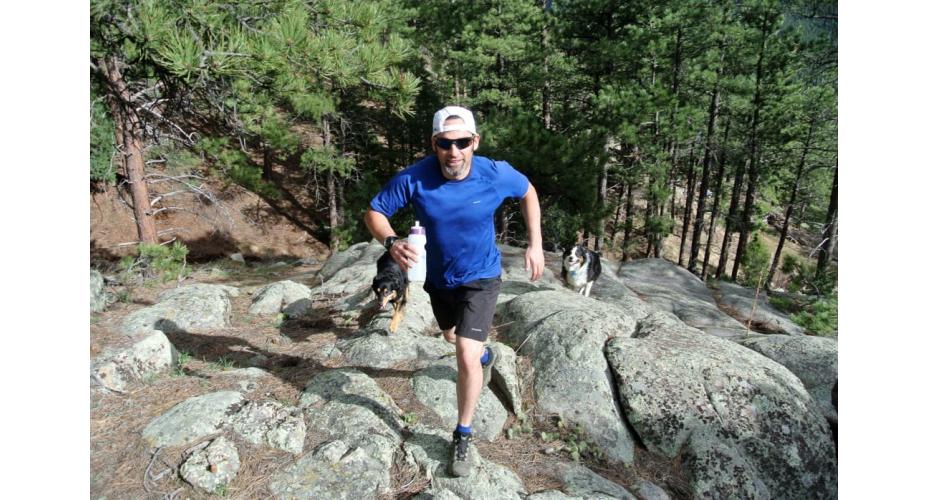
Mountain running has carved out an identity for itself in the Rockies. What was once a small cadre of dedicated enthusiasts has begun to resonate with athletes from other disciplines, from ultra-runners to day hikers. More than simply covering ground for the sake of movement, mountain running introduces the contrasting need for a deep understanding of the terrain with the promise of freedom while running in dynamic, ever-changing environments.
Whether looking to reach the top of your local hill or the lofty summits of Colorado’s 14,000-foot peaks, here are ten tips to help you get the most out of your time in the mountains
1. New runners: Walk the steeps, run the flats
One of the joys of mountain running is gauging the evolution of your skills. But if you’re new to the sport, the prospect of staying in motion up an imposing vertical ascent can be daunting. Experienced road runners are often disheartened at how taxing mountain ascents can be; after all, it requires a different type of strength and endurance. One good tip is to start out modestly by jogging the flats and modest inclines and walking the steeps (and steps)—but never stop moving. Work up to jogging through the steeps section by section and eventually piece a complete run together.
2. Pack light (but not too light)
On smaller, local mountains, minimalist gear (water, gels/food, good shoes) is fine, but as you explore into deeper, more remote regions you’ll need to be more prepared. A windproof/ waterproof jacket, arm warmers, small first aid kit, hat, and gloves should be carried when ascending above treeline no matter the time of year.
3. Run the same trail to know thyself
Mountain runners progress in different ways. Monitoring these improvements is best done by training on a familiar trail, where you can work on different skills. This is much more than registering your best time. There’s a lot to figure out: uphill footwork, downhill footwork, pacing, what works best for nutrition, when to recover, when to push, and even reading the weather make up the overall skill set of a mountain runner.
 Running at Hope Pass in the Sawatch Range.
Running at Hope Pass in the Sawatch Range.
4. Stay hydrated and fueled
While this rule applies for all disciplines of running, it’s even more vital for mountain runners. If anything, a slight bit of over-hydrating and over-fueling is a good idea. Your body will be working hard in ways different from road or trail running, especially when it comes to adapting to thin air.
5. Don’t worry about your times
This isn’t to say you shouldn’t do your best to improve, but don’t let your PR be the sole measure of how strong of a mountain runner you’ve become. Wind and weather often make each run a different experience, and getting into the mindset that you ran poorly because of variable trail conditions (or another runner’s PR) can allow you to sell yourself short. If there was a way to measure trail flow, it would likely be the strongest indicator of mountain running progress.
6. Use a short stride
Nearly all competitive mountain runners use small, quick steps to master the ever-changing terrain under their feet. Stability and balance are skills whose importance are amplified in the hills. Mastering a confident stride and pace will allow you to feel sure-footed whether you’re rambling over roots, bouncing off boulders, or skipping through the snow.
7. Don’t neglect downhill running skills
Done right, rolling downhill can feel like floating over the landscape, each step a beautifully timed sequence used to flow down the trail. On the other extreme is the flailing, soon-to-be-face-planted runner who is simply reacting to the trail rather than moving in sync with the terrain. Running downhill is the same art trail runners employ but often at steeper pitches and for longer durations than normal trail runs. Work at becoming fluid and staying in control on your descents, especially when your quads are still searing from the climb.

A slow run up Atlantic Peak's west ridge. James Dziezynski
8. Above treeline, the rules of the mountains still apply
Mountain running streamlines the human engine, so in theory you’ll be equipped to move faster than hikers or backpackers. But remember the mountains move to their own music. Weather, wildlife, unstable terrain, rivers, and snow all require adaptability by mountain runners. Maybe you need to carry micro-spikes or even an ice-axe for certain terrain, or perhaps it’s carrying bear bells and a headlamp. Staying light on your feet—and in your pack—is important, but not at the expense of the natural variables of the mountains.
9. Run with a friend and leave a plan
If you’re headed to remote areas, it’s highly recommended to go with a friend (or, at the very least, let someone know where you are beforehand). Running has a fairly tame reputation, but mountain running ups the stakes, and the last place you want to be is stuck in the remote backcountry miles from rescue. Consider carrying an emergency locator device if you enjoy solo exploration.
10. Train with hill intervals
The bane of many a high school athlete through the years, hills are a great way to train when you can’t make it to the mountains. Not only do they build explosive strength for ascending, they also let you power up your braking muscles for downhill sections. Timed intervals with jogging between hill sprints is a good way to simulate time on the mountain.
Written by James Dziezynski for RootsRated.


